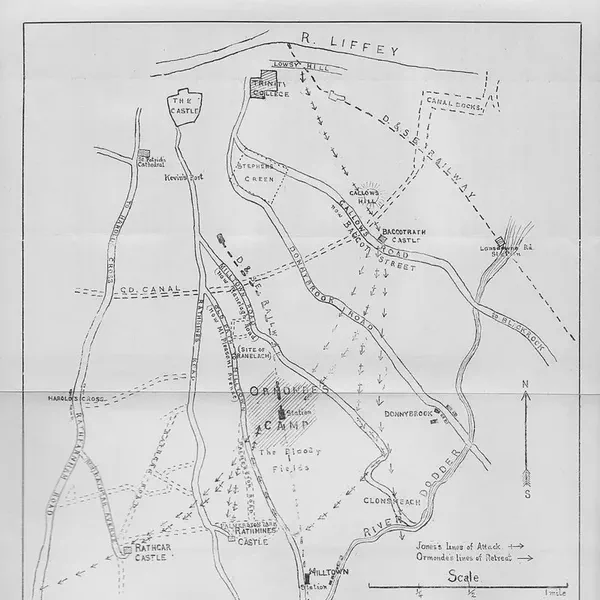On August 01, 1649 in Celtic History
Jones defeats ormond at rathmines, ending royalist hopes of taking dublin

The Battle of Rathmines, fought on August 2, 1649, was a significant event during the Irish Confederate Wars, part of the broader conflict known as the Wars of the Three Kingdoms. This battle saw Michael Jones, the commander of the Parliamentarian forces, decisively defeat James Butler, the 1st Duke of Ormond, who led the Royalist and Confederate forces. The victory at Rathmines effectively ended Royalist hopes of capturing Dublin and was a crucial moment in the Cromwellian conquest of Ireland.
Background
- Wars of the Three Kingdoms: The battle occurred within the context of the Wars of the Three Kingdoms, which encompassed the English Civil War, the Scottish Civil War, and the Irish Confederate Wars. In Ireland, the conflict involved multiple factions, including Royalists, Irish Confederates, and Parliamentarians.
- Royalist Strategy: James Butler, Duke of Ormond, was a leading Royalist commander in Ireland. Following the execution of King Charles I in 1649, Ormond sought to unite the Irish Confederates and Royalists to reclaim Ireland for the monarchy. Dublin, the most important city in Ireland, was a key strategic target for Ormond.
- Parliamentarian Defense: Dublin was held by Michael Jones, a seasoned commander loyal to the English Parliament. Understanding the strategic importance of Dublin, Jones prepared to defend the city against Ormond’s forces.
The Battle
- Initial Movements: Ormond moved his forces towards Dublin in late July 1649, hoping to capture the city before the arrival of Oliver Cromwell’s main Parliamentarian army. He camped at Rathmines, a village just outside Dublin, intending to lay siege to the city.
- Surprise Attack: On the night of August 1, 1649, Jones launched a surprise attack on Ormond’s forces at Rathmines. The Parliamentarians caught the Royalists off guard, leading to a chaotic and decisive battle.
- Outcome: The battle ended in a comprehensive defeat for Ormond. His forces were routed, suffering heavy casualties, and losing much of their equipment. Ormond himself narrowly escaped capture. The victory was so complete that it effectively crushed the Royalist and Confederate cause in the area.
Significance
- Strategic Impact: The defeat at Rathmines destroyed Royalist hopes of capturing Dublin, which was crucial for their strategy to retake Ireland for the monarchy. The loss left Dublin securely in Parliamentarian hands, allowing Oliver Cromwell to use it as a base for his subsequent campaign in Ireland.
- Cromwell’s Campaign: The battle cleared the way for Oliver Cromwell’s arrival in Ireland later that month. Cromwell landed in Dublin on August 15, 1649, and began his infamous campaign to subdue Ireland, which included the sieges of Drogheda and Wexford.
- End of Royalist Resistance: The defeat at Rathmines marked a turning point in the Irish Confederate Wars. With the loss of Dublin, the Royalist and Confederate alliance rapidly disintegrated, leading to the eventual conquest of Ireland by Parliamentarian forces.
The Battle of Rathmines was a decisive moment in the struggle for control of Ireland during the Wars of the Three Kingdoms. Michael Jones’s victory ensured Dublin remained in Parliamentarian hands and set the stage for Cromwell’s brutal campaign, which would have lasting consequences for Ireland.
More From This Day




Irish Constabulary Act sets up county police forces and salaried magistracy
August 01, 1822
The Act of Union dissolves the Irish parliament and transfers legislative powers to Westminster
August 01, 1800






Druids of Gaul recognize Roman authority in exchange for religous toleration.
August 01, 18 BC